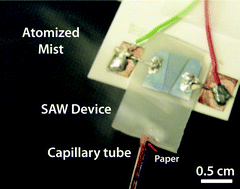The extraction of liquid, protein molecules and yeast cells from paper through surface acoustic wave atomization†
Abstract
Paper has been proposed as an inexpensive and versatile

* Corresponding authors
a
MicroNanophysics Research Laboratory, Department of Mechanical and Aerospace Engineering, Monash University, Melbourne, VIC, Australia
E-mail:
james.friend@eng.monash.edu.au
b Bio-Engineering Laboratory, Department of Chemical Engineering, Monash University, Melbourne, VIC, Australia
Paper has been proposed as an inexpensive and versatile

 Please wait while we load your content...
Something went wrong. Try again?
Please wait while we load your content...
Something went wrong. Try again?
A. Qi, L. Yeo, J. Friend and J. Ho, Lab Chip, 2010, 10, 470 DOI: 10.1039/B915833B
To request permission to reproduce material from this article, please go to the Copyright Clearance Center request page.
If you are an author contributing to an RSC publication, you do not need to request permission provided correct acknowledgement is given.
If you are the author of this article, you do not need to request permission to reproduce figures and diagrams provided correct acknowledgement is given. If you want to reproduce the whole article in a third-party publication (excluding your thesis/dissertation for which permission is not required) please go to the Copyright Clearance Center request page.
Read more about how to correctly acknowledge RSC content.
 Fetching data from CrossRef.
Fetching data from CrossRef.
This may take some time to load.
Loading related content
